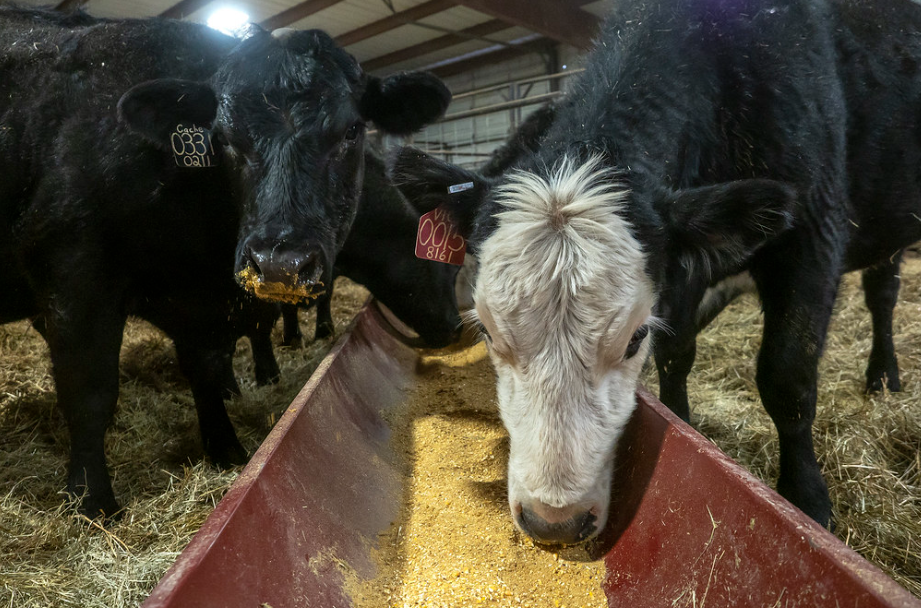
Mark Johnson, Oklahoma State University Extension Beef Cattle Breeding Specialist, offers herd health advice as part of the weekly series known as the “Cow Calf Corner” published electronically by Dr. Peel, Mark Johnson, and Paul Beck. Today, Johnson talks about using growth implants and protein supplementation to increase return on investment figures.
Return on investment (ROI) should be considered for inputs of feed, capital improvements and management in commercial cow-calf operations. This article looks at a couple of summer management practices for growing calves that offer a great ROI relative to time and cost.
Growth Implants
Data from over 2300 head of suckling calves collected by Merck Animal Health shows an additional 23 pounds of weaning weight gained as a result of zeranol growth implants. In the current market, assuming a conservative value of an additional pound of weaning weight at $3/pound, which is an additional $69 per head from an implant cost of less than $2 per head. Considering the cost of labor for time spent giving the growth implant (which easily fits a management schedule when giving the first round of vaccinations at two to four months of age), the return on investment is over $60 per head.
Protein Supplementation
The Oklahoma Gold and Oklahoma SuperGold supplementation programs both serve as a means of adding profit potential and offer an excellent ROI. Both are designed to cost effectively improve the growth of calves and stocker cattle grazing pastures in late summer and fall. Both are based on limit feeding high protein supplements. Crude Protein (CP) content and digestibility of warm season grasses declines during mid-summer and fall. No doubt many Oklahoma producers watched green pastures turn brown during the past few weeks of intense heat and this corresponds with declining quality of standing forage. In late spring and early summer calves can gain 2 – 3 pounds/day on the same pastures that now may be limiting gains to less than half that amount, even with ample standing forage. Why? Because cattle’s growth performance is based on the most limiting nutrient in their diet. The same grasses that would have contained over 10% CP in May now are likely closer to 7% CP. A 500 lb. calf gaining 1.5 pounds/day requires a diet containing a minimum of 10% CP. Bottomline: at this point in the summer, CP has become the growth limiting factor in a calf’s diet. The key to improving growth rates is protein supplementation. As opposed to high energy creep feeds, Gold and SuperGold programs are designed to improve growth rate through high protein supplementation when ample standing forage is available. The Oklahoma Gold program includes a 38% CP supplement at a rate of 1 pound/day and includes an ionophore additive along with vitamins and minerals. The Oklahoma SuperGold program is similar as it includes supplementing a 25% CP at a rate of 2.5 pounds/day. The Oklahoma Gold program is one of the most cost effective and industry proven supplementation programs ever developed. From early June to October, several trials conducted at OSU, indicate feeding 1 pound/day of Gold can increase gains of stockers grazing summer pastures by up to 0.6 pound/day. Furthermore, the Gold program is based on a low volume of feed and offers the flexibility of feeding every-other-day. In some situations the SuperGold feeding program may offer advantages. Remember, both of these feeding strategies work based on ample standing forage. More details for both feeding strategies can be found at http://osufacts.okstate.edu in the fact sheets referenced below.
References:
Trust in Beef Sustainable Ranchers Tour. Animal Care on the Ranch. Deana Hardee, DVM Merck Animal Health. June 20, 2024
Oklahoma Cooperative Extension Fact Sheet ANSI-3032. Oklahoma Gold Q&A.
Oklahoma Cooperative Extension Fact Sheet ANSI-3033. Oklahoma SuperGold Q&A.


















